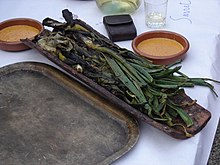Socks
The calçot (pronounced /kəl'sɔt/) is a variety of spring onions. The calçot de Valls is a product with a Protected Geographical Indication (PGI) that is characterized by a length of 15 to 25 cm (white part) and a diameter, measured 5 cm from the root, of between 1.7 and 2.5 cm.
They are common in the inland area of Catalonia (Spain), but especially in the entire western area, corresponding to the Ebro lands and the Alto Campo region, and it is the most emblematic dish of the town of Valls (Tarragona). It is one of the typical dishes of Catalan gastronomy, widely consumed at the end of winter with romesco sauce or salvitxada, completing with a second course made up of typical meats and sausages.
Origin of name
“Calçot” comes from the fact that during its cultivation, earth is piled on top of the shoots that grow from the initial onion ("calçar la terra sobre la planta"). This is done to get a white stem of about 20 to 25 cm.
Origin
One of the most commonly accepted versions states that its discovery is due to Xat de Benaiges, a late 19th-century farmer from the Valls area (Province of Tarragona), who inadvertently, grilled some "onions" that he overheated. They were all burned on the outside, and instead of throwing them away, he peeled off the burnt outermost layers, discovering that the inside was very tender and flavorful.[citation needed]
Consumption
Young stems are eaten and can be done between late winter and early spring. The calçot forms the basis of the popular calçotades that are celebrated in Catalonia, which have become a festival in which they are eaten roasted preferably over the live flame of &# 34;redoltes de ceps" (vine shoots). You don't have to wait for it to be grilled, which is how the meat would be roasted. Once done, when the outer layers are black, ajar and foamy, they are wrapped in groups of approximately 25 in several sheets of newspaper and left for at least half an hour to finish cooking with their own heat. They are eaten by peeling the outer layers and spreading the calçot in a sauce called salvitxada or also with romesco sauce.
Once the calçots have been consumed and after washing their hands (they are completely black), they eat meat and sausages roasted over the embers that remain after making the calçots, all washed down with wine or cava.
Nutritive properties
As they are onion sprouts, their nutritional properties are the same, that is, they have a wide content of vitamins and minerals. In addition, diuretic, toning, digestive and aphrodisiac properties are attributed to it.
Cultivation
The bulbs are obtained from the sowing of seeds. The seeds are planted at the end of winter, the chives are transplanted in spring and the bulbs are harvested in summer. In mid-September the bulbs can be planted in the ground and as they grow they are shoeing, that is, covering them with soil so that they remain white.
Cultivation of calçot is common in the regions of the province of Tarragona near the sea and with mild winters. Although it is also grown indoors, in areas that do not have strong frosts, they are harvested a little later than the calçots of the coast.
Admits urban cultivation in pots.
Contenido relacionado
Department of Cusco
Edo
Aleutian Islands


